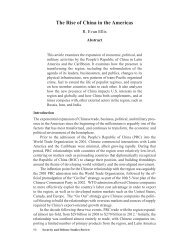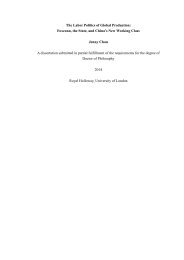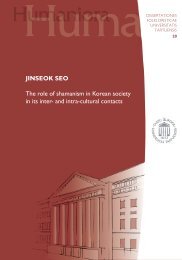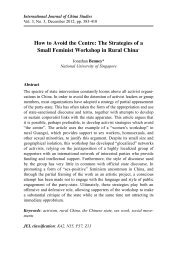Confucius Institutes v2 (1)
Confucius Institutes v2 (1)
Confucius Institutes v2 (1)
Create successful ePaper yourself
Turn your PDF publications into a flip-book with our unique Google optimized e-Paper software.
10 CONFUCIUS INSTITUTES AND THE GLOBALIZATION OF CHINA’S SOFT POWERaccess, recognition, and surpassing established institutes areformidable.While the raw numbers are impressive, focusing on the numbersas a competitive indicator of cultural diplomacy’s effectivenessmay obscure the valuable lessons and insights that other countriescan glean from China’s CI initiative. 6 The very name of the projectis revealing. Naming the institutes after the Chinese philosopher<strong>Confucius</strong> (551-479 BC) was originally intended to symbolize thelongevity of the Chinese culture, as well as the longevity envisionedfor the initiative. <strong>Confucius</strong> also captures the essence of Chineseculture, as it is permeated with Confucian values. 7 At the core ofConfucian ethics are proper human relations; humans are viewedprimarily as relational beings. 8 As this study illustrates, the Chinesephilosopher and the <strong>Institutes</strong> share most deeply this emphasis oncultivating and maintaining relationships.Relational structures and relational dynamics are the pivotalfeatures of the <strong>Confucius</strong> <strong>Institutes</strong>. Unlike most cultural institutesthat are stand-alone, independent entities in a host country, CI arepartnered with a Chinese university, and both are linked to the CIheadquarters in Beijing. This in effect creates a multi-dimensional,multi-layered global network structure. The relational structureis only part of the picture. Equally important are the relationaldynamics. The CI initiative’s many online and offline activities arenot just culturally themed, they also contain powerful elements ofinternal and external relationship-building that lead to collaboration.Understanding the relational dynamics is key to understanding thegrowth, sustainability, and collaborative benefits of the CI.This paper examines the CI initiative as a process model of anetwork collaborative approach to cultural diplomacy. The paperlooks at relational structure and relational dynamics through thelens of the “soft power differential” and network communicationapproach. The first section expands the idea of the soft powerdifferential in public diplomacy to cultural diplomacy. Thesecond section provides a strategic overview of the CI initiative






